This was published 5 years ago
Destination dishes: The world's most amazing restaurants and their dishes only locals know about
By Ute Junker
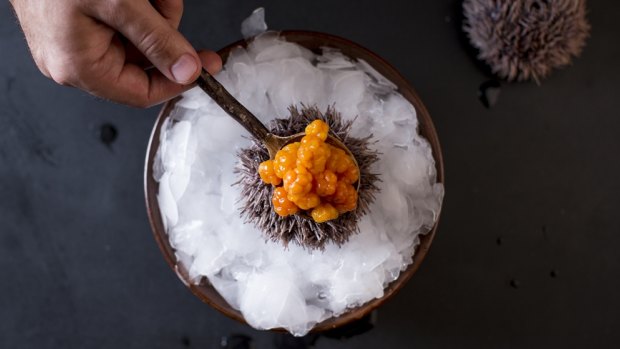
Exotic dishes including sea urchin now feature in top Russian restaurants including White Rabbit in Moscow.
How far have you have travelled for a good feed? A few decades ago, crossing town for a meal would have been considered rather adventurous. These days, of course, we happily jet halfway across the globe to treat our taste buds to a Michelin-starred meal or fresh-from-the-grill street food.
It is a long way from the days when France was considered the only serious destination for foodies. Today, new gourmet getaways spring up like mushrooms after a downpour. In Europe, travellers are discovering that countries such as Turkey and Belgium offer just as many culinary delights as Italy and Spain. Asia exerts a magnetic pull on diners, who flock to Vietnam to chow down on pho, to Singapore to feast on chicken rice, or to Japan to eat – well, everything. Even South America has attracted the attention of gastro-nauts eager to sample Argentina's superb steaks and Peru's ever-surprising cuisine.
So in this age of global gourmands it is possible that have we conquered every food frontier, or have we? Are there any unsung destinations left for diners to discover? When we put this question to some of Australia's best chefs, the answer, perhaps surprisingly, was yes. From the fragrant cuisine of Iran to the Mediterranean melting pot of Malta, these are the under-explored countries that our panel picks as the new frontiers for hungry travellers.
THE PLACE: RUSSIA
THE CHEF: Alla Wolf-Tasker
FOOD FOR THOUGHT: "The two bedrocks of Russian cuisine – the Orthodox church and its feast days, and the dacha, the summer house where Russians grow their own food which they pick and preserve – were present when I was growing up in Melbourne in a very Russian household. Memories of a group of friends around the kitchen table trimming and slicing the morning's foraged mushrooms, and the shared feasts at the end of the day – the pelmeni, the piroshki, the cabbage rolls – led to my career as a restaurateur. Travel in Russia today and the drab and dreadful food of the Soviet Union's people's dining halls has been replaced by young chefs resurrecting and modernising traditional Russian flavours."
THE ONE DISH YOU SHOULD TRY: "I'd have to say kievsky kotlety, a far cry from the ubiquitous chicken Kiev we have come to know. We recently enjoyed a superlative version at Yat on the River Moika embankment in St Petersburg. It is a super simple little cellar just a stone's throw from the Palace Square, run by very young people reimagining the food of their grandparents."
ONE MORE THING: "Sanctions on European goods imposed in the past few years have probably been one of the best things to happen to the country. A fervour for producing and growing their own rather than relying on imports has spawned a new generation of young producers. Farmers markets and food fairs with conversations around sustainability and regeneration, have become the norm. At the vanguard is Vladimir Mukhin of White Rabbit Moscow (No.15 on the World's 50 Best Restaurants list). What a joy to taste the familiar flavours of my youth in an exciting new context."
ESSENTIALS: traveller.com.au/russia; russiatourism.ru; facebook.com/restaurant.yat; whiterabbitmoscow.ru
THE PLACE: ISRAEL
THE CHEF: Michael Rantissi
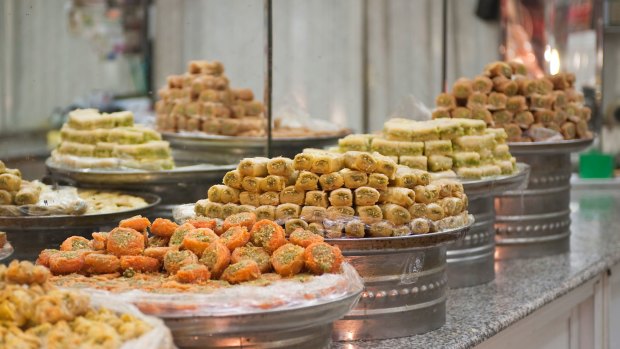
Credit: Alamy
FOOD FOR THOUGHT: "I grew up in Israel, and I still head back almost every year. Israel's food scene has changed immensely in recent times. We always had great home cooking, but now there are also plenty of fine dining restaurants. You can have a magnificent meal overlooking the beach in Tel Aviv, or you can head to the wonderful markets. Israel is a melting pot of culture and food, thanks to immigration: people from Europe and America, Yemen and Morocco, have all brought their native flavours and added them to the mix. Meat has traditionally been very expensive, so vegetarians will find plenty to eat. There are some remarkable chefs at work including Eyal Shani, who blends modern Mediterranean flavours with his own Rumanian heritage. He runs a number of restaurants in Tel Aviv including HaSalon."
THE ONE DISH YOU SHOULD TRY: "One of the most magical things about Israel is its street food culture. Restaurants can be very expensive, but you can always get great food at one of the simple food stands dotted throughout the cities, each specialising in just one food. Some of them have been going for decades, handed on from one generation of the family to the next. In Tel Aviv's old quarter, Jaffa, Abu Hassan on Dolphin Street makes magnificent hummus. The doors open at 8am and close at 1 or 2pm when it has sold out of stock."
ONE MORE THING: The Jewish sabbath is on Saturday, so many places are closed. Thursday and Friday nights are the popular nights to head out.
ESSENTIALS: traveller.com.au/israel; new.goisrael.com
THE PLACE: CYPRUS
THE CHEF: Darryl Martin
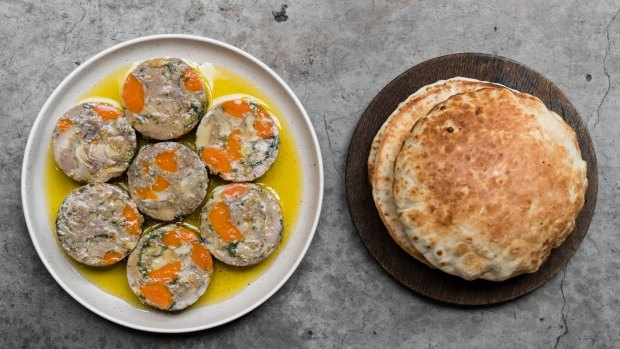
Credit: Nikki To
FOOD FOR THOUGHT: "My wife has a Cypriot background, which is how I became inquisitive about the region. She has a lot of family there, so we have visited quite a few times. Cypriot food is often associated with Greek food, and there is a lot of crossover – if you know Greek dolmades, or stuffed grape leaves, Cyprus' koupepia will look familiar – but you will also find quite distinctive dishes. The spices, pinenuts and dried fruits are from north African and Middle Eastern influences; the use of coriander and cumin really pumps it up. It's a real melting pot. The Cypriot diet is very meat heavy, although you will find a lot more seafood down south. There is a lovely dish called lountza, smoked pork loin marinated in red wine and pepper. I also love zalatina, which is a pig's head boiled with cinnamon and herbs, strained and put in a jar. It reminds me of a French terrine. Dinner is the main meal, and to go with the meat you will have a whole bunch of fresh vegetable dishes to lighten things up."
THE ONE DISH YOU SHOULD TRY: "Kleftiko is lamb slow-cooked in an oven for hours and hours. You will often see the oven outside the restaurant; it's pretty much the first thing they build. They drop a slab of concrete, build in the oven, add chairs and tables and there you go. The lamb is cooked with lots of tomato and onion, cinnamon and dried herbs such as rosemary. It is always served with leavened bread."
ONE MORE THING: "When you are eating in a village restaurant, don't look for a menu. Don't even try to order. Just sit down and they will start bringing food. You get what you're given."
ESSENTIALS: traveller.com.au/cyprus; visitcyprus.com
THE PLACE: CAMBODIA
THE CHEF: Christine Manfield
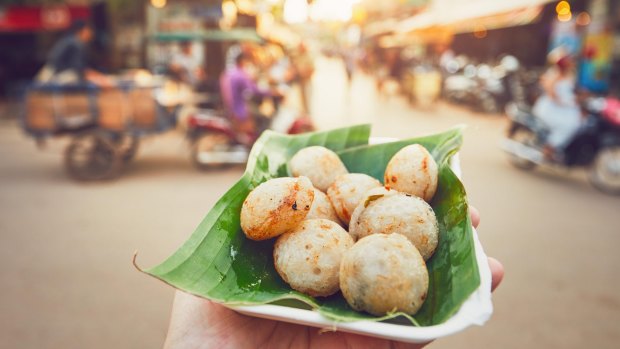
Credit: Alamy
FOOD FOR THOUGHT: "I have been a frequent visitor to Cambodia since 2004. Across many visits, I have witnessed a country emerging from the ravages of its recent history of war and genocide. Its people are forward-looking with a fierce resilience and optimism, rebuilding a culture severely damaged by the Khmer Rouge regime, when disruption created a loss of tradition and cultural identity. Food is at the heart of that reinvention. Cambodian cuisine is complex, with influences as diverse as French, Chinese, Indian, Thai and Vietnamese, and it is all about balancing salty, sweet and bitter flavours. Classic dishes include fish amok, banana blossom salad and saraman, a curry of beef, ginger and peanut. There is plenty of street food and colourful markets where you can discover local ingredients such as the pungent prahok, a fermented fish paste that is a Cambodian staple and an acquired taste for the western palate. Equally aromatic, and less challenging, is Kampot pepper, grown on the south coast and celebrated around the world for its delicate, fruity flavour. The pepper is only now being grown again on a large scale; this was just another of the industries destroyed by the Khmer Rouge."
THE ONE DISH YOU SHOULD TRY: "My go-to dish is nom ben chok – green curry breakfast noodles that reveal the subtleties of Khmer cooking. The layered flavours are underpinned with prahok. As one of Cambodia's most popular breakfast dishes, it is dispensed from roadside vendors and local cafes right across the country. The rice noodles are an artisan product made by women in the countryside and brought to markets across the country every morning."
ONE MORE THING: "If you are looking for a great souvenir, visit Happy and Co Farm's shop in Siem Reap. This is a brilliant initiative designed to create employment for locals by growing organic sustainable produce on neglected rice fields."
ESSENTIALS: traveller.com.au/cambodia; tourismcambodia.com; happyandcofarm.com
THE PLACE: IRAN
THE CHEF: Greg Malouf
FOOD FOR THOUGHT: "We [with co-author Lucy Malouf] had done a number of books about Middle Eastern food and following lengthy chats with our publishers, we decided Iran was the next obvious place to focus on. We knew very little about the cuisine; in the two years it took to put together the book Saraban, we immersed ourselves in Persian cuisine and culture. We travelled all over Iran and discovered that it is a huge country with an incredibly diverse and sophisticated cuisine. Their rice is legendary: they grow their own type of rice and put it through an ageing process which gives it heaps of flavour. They have a very interesting technique of cooking it so that it forms a crust on the bottom of the pot. If you are invited to someone's house – and you will be invited to someone's house – you will always be offered the crunchy part of the rice. They also use a lot of saffron, turmeric, ginger and cumin as well as a lot of fresh herbs. They don't have a huge restaurant culture; the best meals are enjoyed at home. Their hospitality is extraordinary."
THE ONE DISH YOU SHOULD TRY: "Fesanjan duck tastes better than it looks. The duck is slow-cooked with walnuts and pomegranate until the meat falls apart. It is a beautiful dish that is also very rich with flavours that are sweet and sour and meaty. You will find it all over the country; they use duck in the north, but in Tehran they make it with chicken."
ONE MORE THING: "Iranians don't usually eat at tables. A cloth is spread on the floor and all the food laid out; everyone sits around it and eats, argues and talks."
ESSENTIALS: traveller.com.au/iran, itto.org
THE PLACE: MALTA
THE CHEF: Shane Delia
FOOD FOR THOUGHT: "Both my parents are Maltese, so we grew up eating Maltese food. Every Sunday we'd go to my mum's parents for lunch, then my dad's parents for dinner. My grandfather used to make a braised Maltese rabbit dish that was a beautiful collection of Moorish flavours, including raisins and toasted walnuts. Malta has been raped and pillaged by everyone over the years, and everyone who took over left a little culinary influence behind. So you get dishes that are more true to Arabic tradition like bigilla, fava bean puree flavoured with marjoram, garlic and chilli. It's very tasty and very smelly. Then there are semolina-based sweets that are more in the Sicilian tradition. There is lots of seafood, of course, but rabbit and horse were traditionally popular; in a war-torn country, you eat what's around. There is a high-level restaurant scene in Valletta but if you want the real taste of Malta, head for the villages where the restaurants are cooking family recipes that have been passed down over generations."
THE ONE DISH YOU SHOULD TRY: "Pastizzi is Malta's national snack food. It's a heavenly parcel of flaky, crunchy calorie-ridden pastry encasing either a filling of ricotta or braised peas spiced with clove, anise and onion. Eat one and before you know it, you have eaten a dozen and put on three kilos. You will find them in every restaurant and on every corner. It's very laborious to make by hand, but you can taste the difference. If it's triangular and looks like it was made by a machine, give it a miss."
ONE MORE THING: "Malta is a small island, but it is worth travelling around to try different dishes. Marsaxlokk port is the place to eat seafood. If you want high-end dining, head for Valletta. On Gozo, try the local pizza."
ESSENTIALS: traveller.com.au/malta; visitmalta.com
THE PANEL
SHANE DELIA
In addition to running his Melbourne restaurants, Maha and Biggie Smalls, Shane Delia also hosts TV shows such as the internationally acclaimed Spice Journey. He is the author of several cookbooks and was invited by the Maltese prime minister to sit on the Council for Maltese Living Abroad.
GREG MALOUF
With his Lebanese heritage and ground-breaking Melbourne restaurant, MoMo, Malouf is credited with bringing Middle Eastern food into the mainstream in this country. Malouf went on to helm the Michelin-starred Petersham Nurseries in London before moving to Dubai, where he has run two restaurants and is now a consulting chef. Greg has also co-authored a number of books on Middle Eastern food.
CHRISTINE MANFIELD
After decades of running acclaimed restaurants in Australia and Britain, Christine Manfield now hosts bespoke gastronomic tours to destinations including Asia, Africa, Europe, South America and Australia. She is also the author of a number of books including Dessert Divas and Tasting India.
DARRYL MARTIN
Quay and the Three Weeds Hotel are just a couple of Sydney dining institutions Darryl Martin worked at before opening his first Barzaari restaurant in 2016. The original Marrickville location has been joined by a Chippendale branch, where he serves innovative food inspired by the flavours of the Middle East, including Cypriot, Lebanese and Syrian cuisines.
MICHAEL RANTISSI
Born and raised in Tel Aviv, Michael Rantissi has worked in New York, Paris and London as well as Sydney. He currently runs two restaurants, Kepos Street Kitchen and Kepos & Co, which showcase modern Middle Eastern food. He has published a number of cookbooks, most recently Hommos & Co.
ALLA WOLF-TASKER
With her Lake House restaurant in the Victorian town of Daylesford open for more than three decades, Alla Wolf-Tasker virtually invented destination dining in Australia. She has long been an advocate for small producers and is a Member of the Order of Australia.
MORE FORGOTTEN FRONTIERS OF FOOD
Hankering for more exotic flavours? Try one of these under-the-radar destinations.
ETHIOPIA You don't need cutlery to enjoy a traditional Ethiopian feast: injera, the sour pancake-ish bread that is an Ethiopian staple, is used to scoop up the range of flavour-packed stews, curries and vegetable dishes served in a typical meal.
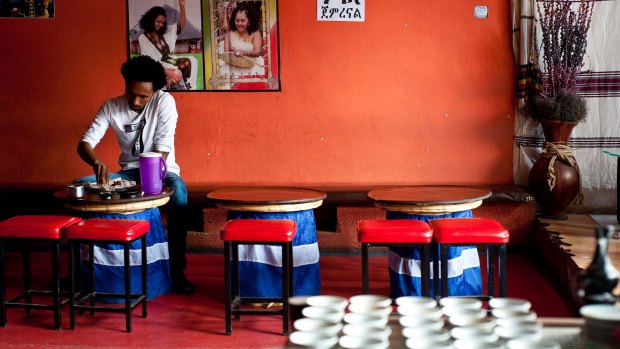
Credit: Alamy
ECUADOR On the coast, try ceviche or encocado, seafood in a spicy coconut sauce. In the highlands, stop at the local market and have a slice of hornado (whole roast pig), or work your way through the many corn-based dishes, from corn tortillas to the corn dumplings called humitas.
GEORGIA The Mediterranean meets the Middle East in Georgian cuisine, where typical dishes include khinkali dumplings, badrijani nigvzit (eggplant teamed with walnut paste) and tangy chakapuli lamb stew. Don't miss the more-ish khachapuri, cheese-stuffed bread.
BANGLADESH Bangladeshi cuisine, also known as Bengali cuisine (before Partition, Bangladesh was part of the state of Bengal), is full of aromatic dishes. Try hilsa fish served in a mustard sauce or haleem, a rich lentil, barley and meat dish.
TRINIDAD AND TOBAGO Trinidad and Tobago proudly claims to have the best cuisine in the Caribbean, drawing on Portuguese, Chinese, African and Indian influences. Street food favourites include curry crab and dumplings and "doubles" of fried dough stuffed with curried chickpeas.
FORGOTTEN FRONTIERS OF WINE
You have drunk drops from Italy and Argentina, South Africa and Spain, but are you au fait with these under-rated wine regions?
BOLIVIA With just 3000 hectares under vines, Bolivia's wine industry, centred around the pretty town of Tarija, is tiny compared with those of neighbouring Chile and Argentina. Its high-altitude wines nonetheless include some award-winning drops.
GREECE Move over retsina: Greece's wine producers are flourishing, building up a reputation for very drinkable wines at bargain-basement prices. Try malagousia from Macedonia, agiorgitiko from the Peloponnese or Santorini's acidic assyrtiko.
THAILAND Beaches, temples… wineries? Yes, Thailand has joined the ranks of the world's wine producers. Its most famous winery, the award-winning Monsoon Valley, can be visited on a day trip from Bangkok. Unusually, its vines are planted between canals to keep them alive in the tropical heat.
CANADA It is best-known for its ice wines but Canada also produces plenty of other quality wines, with 100 wineries in the Niagara region alone. Another top tip for wine lovers is the booming Okanagan Valley, which produces some superb wines.
ARMENIA They have been making wine a long time in Armenia: at least 6000 years, judging by the latest archaeological finds. Today boutique producers are getting global attention for interesting wines such as the white voskehat and the full-bodied red khndoghni.
BEST-FORGOTTEN FRONTIERS OF FOOD
It hurts when the world doesn't like your food. Just ask the natives of these countries, whose cuisines are famously unappreciated by outsiders.
ICELAND Scenery: spectacular. Cuisine: not so much. Hard to pick which dish comes top (or is it bottom?) in the please-don't-make-me-eat-it stakes: kutmagar (fish stomach stuffed with fish liver), hakarl (fermented shark), hvalspik (whale blubber) or slatur – literally, "slaughter" – a blend of sheep's innards, blood and fat.
MONGOLIA They love mutton. They love horsemeat. And they wash it down with mare's milk fermented in a cowhide container. Mongolia certainly has a distinctive cuisine; whether it will ever catch on beyond the country is debatable.
NEPAL Lentil soup. Rice. Vegetables. Eat. Repeat. Few people would argue that Nepalese cuisine is bad; simply that it is repetitive. Would you like some lentil soup with that?
GHANA Popular dishes in Ghana include fufu, a starchy mass of boiled cassava and plantain. Also banku, a starchy mass of ground fermented corn and cassava. And kenkey, boiled ground fermented corn. Do we sense a pattern here?
TONGA Mutton flaps. Sounds unappetising, tastes worse. Yet it's a favoured dish in Tonga. This South Pacific island may have beautiful palm-fringed beaches but gourmet cuisine? Not yet, I'm afraid.
Sign up for the Traveller Deals newsletter
Get exclusive travel deals delivered straight to your inbox. Sign up now.